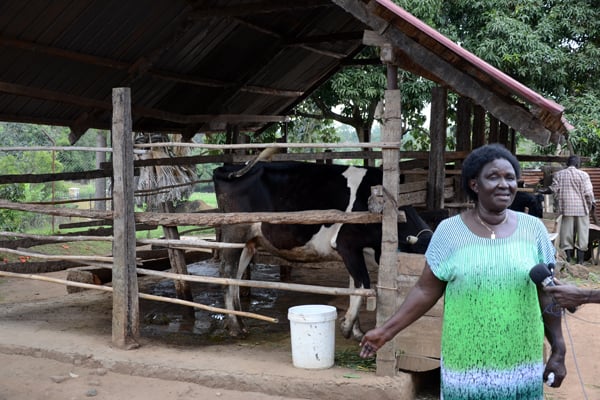Housing requirements under zero grazing for starters

A small structure like this must ensure enough space for cattle feeding, exercise while stressing safety and security. Photo/George Katongole
What you need to know:
- As an absolute minimum, the housing must provide a comfortable, clean, well-drained and dry lying area together with shelter from adverse weather, space to allow the animal to move, lie down and rise freely as well as have access to adequate food and water.
- Feeding troughs can be made from old water baths, used tractor tyres or wood. The mineral block should be placed in each cubicle to limit fighting between the animals.
Dairy production is increasingly becoming more difficult particularly in peri-urban settings where land is scarce.
This implies that intensive dairy farming systems are more applicable to increase the efficiency of land utilisation.
But many people are inspired to start small scale dairy production to meet nutrition and financial needs.
According to extension workers, there are many requirements to be considered while starting a small scale dairy operation including the type of breed to keep, reproduction methods and feeding systems, among others, but the housing needs of the animals are critical.
The basics
James Mugerwa, a retired extension worker and a smallholder dairy farmer in Mukono, notes that in the first place, a proper cattle shed should make the animals safe and comfortable.
He says that the housing must be put in place with consideration for safety, manure handling, ventilation, isolation and biosecurity.
“Since the operations are routinely done in a small area, all details must be considered,” Mugerwa says.
He explains that a productive dairy animal is a costly investment that needs to be protected from vandalism or malicious poisoning.
For the comfort of the animal, manure, which is a daily by-product, must be properly disposed of while ventilation is key in managing heat stress.
In zero grazing, he adds, there is increasing need to isolate animals especially when fights break out or during mounting, which might cause injuries. Isolation is also key in controlling breeding and spread of diseases.
To allow proper ventilation, Mugerwa explains that open sided, single slope roof shed are highly recommended. “These structures are the least expensive and very easy to build,” he says.
A footbath is another recommendation which he says must be filled with disinfectants weekly. Cleaning is a daily routine to stop foot rot.
Consideration should also be made on calf housing to enable them to be fed individually up to at least two months. The hutches, he says, should be well bedded with straw and kept dry.
But Dr Hussein Kato, a livestock nutrition scientist at the National Livestock Resources Research Institute (NaLIRRI), Namulonge, stresses the importance of the comfort of the animals.
Cow comfort is an important part of maintaining a healthy herd. “Apart from housing cows in well ventilated and clean cubicles, they should be provided plenty of space to exercise,” Dr Kato says.
He adds that clean bedding materials such as sand, sawdust or rubber mats should be used.
“The beddings help the cows’ udders to keep them clean and comfortable when lying down,” he stresses.

Details
In simple terms, a zero grazing unit has eight main components including; cubicles, walking area, resting area, feed and water troughs, milking place, calf pens, store and manure pit.
According to Mugerwa, the construction of these particular areas should be handled with the help of local veterinary doctors.
He says that the walking area, which is recommended to have a gradual slope, should be made of concrete to ease cleaning. A rough concrete floor, he says, will stop the cow from slipping.
“As a principle, feeding and water troughs should be raised to avoid contamination,” he adds.
Feeding troughs can be made from old water baths, used tractor tyres or wood. The mineral block should be placed in each cubicle to limit fighting between the animals.
Milking area
Dr Kato explains that particular consideration must be given to the milking area to ensure clean milk production.
Prior planning for calves is important in managing herd expansion. Though most farmers use makeshift structures for calves, it can be disastrous.
“There is a possibility of exposing them to infections and diseases yet if they are housed together, it is difficult for each animal to attain individual feed requirements,” he adds.
Mugerwa stresses that it is important to ensure the cost of the facility is within the objectives and means of the operation.
“Even if you are planning a big operation, I advise farmers to start with simpler, cheaper systems and invest into complex systems as the business grows,” Mugerwa says.




